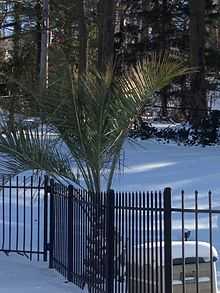Butia capitata
| Butia capitata | |
|---|---|
| | |
| Butia capitata, Tresco, Isles of Scilly, UK | |
| Scientific classification | |
| Kingdom: | Plantae |
| (unranked): | Angiosperms |
| (unranked): | Monocots |
| (unranked): | Commelinids |
| Order: | Arecales |
| Family: | Arecaceae |
| Genus: | Butia |
| Species: | B. capitata |
| Binomial name | |
| Butia capitata (Mart.) Becc.[1] | |
Butia capitata, also known as Jelly Palm, is a palm native to Argentina, Brazil and Uruguay.[1] This palm grows up to 6m (exceptionally 8m) in a slow but steady manner. It is easily identifiable with feather palm pinnate leaves that arch inwards towards a thick stout trunk.
Butia capitata is notable as one of the hardiest feather palms, tolerating temperatures down to about −10 °C; it is widely cultivated in warm temperate regions. For example, it is commonly grown on the East Coast of the United States as far north as Virginia Beach, Virginia and Seattle, Washington on the west coast.
Ripe fruit are about the size of large cherry, and yellowish/orange in color, but can also include a blush towards the tip. The taste is a mixture of pineapple, apricot, and vanilla. Taste can vary depending on soil conditions, and the tastes of apple, pineapple, and banana together is also common. It is tart and sweet at the same time, with a flesh similar to a loquat, but slightly more fibrous.
Chemistry
The triterpenes cylindrin and lupeol methyl ether can be isolated from Butia capitata leaf epicuticular waxes.[2] The pulp is a good source of β-carotene and provitamin A.[3]

Gallery
-

Ripe fruit of Butia capitata palm growing in Ocean Isle Beach
-

Butia capitata palm growing in Ocean Isle Beach, bearing both ripe and unripe fruit
References
- ↑ 1.0 1.1 "Taxon: Butia capitata (Mart.) Becc.". Germplasm Resources Information Network (GRIN). United States Department of Agriculture, Agricultural Research Service, Beltsville Area. Retrieved 2010-04-24.
- ↑ Triterpene methyl ethers from palmae epicuticular waxes. S. García, H. Heinzen, C. Hubbuch, R. Martínez, X. de Vries and P. Moyna, Phytochemistry, August 1995, Volume 39, Issue 6, Pages 1381–1382, doi:10.1016/0031-9422(95)00173-5
- ↑ Fruits of Butia capitata (Mart.) Becc as good sources of β-carotene and provitamin A. Juliana Pereira Faria, Egle M. A. Siqueira, Roberto Fontes Vieira and Tânia da Silveira Agostini-Cost, Revista Brasileira de Fruticultura, Oct. 2011, vol.33, no.spe1, doi:10.1590/S0100-29452011000500084
External links
- http://www.sunpalmtrees.com/Cold-Hardy-Palm-Trees-Pindo-Palms.htm
- http://hort.ifas.ufl.edu/database/documents/pdf/tree_fact_sheets/butcapa.pdf